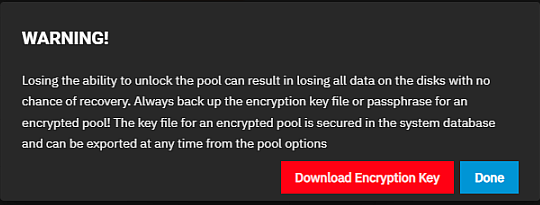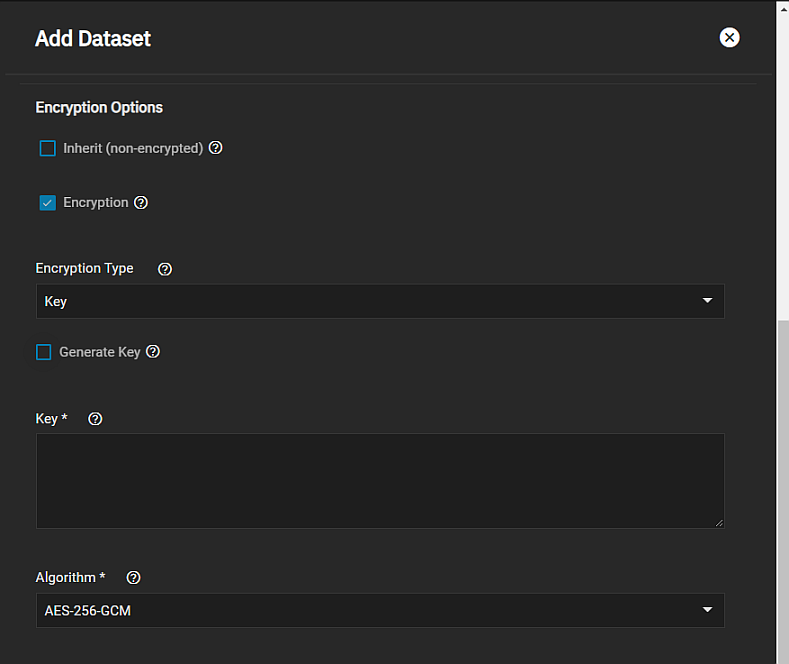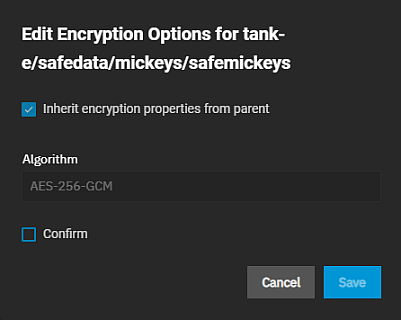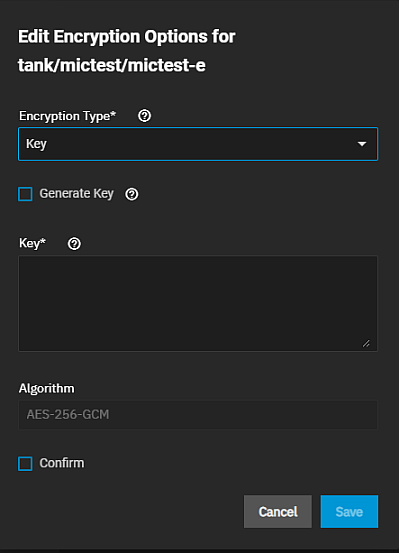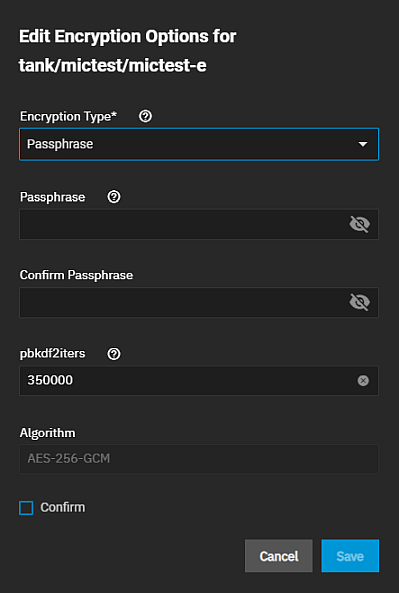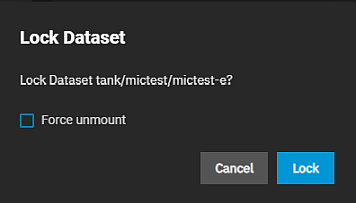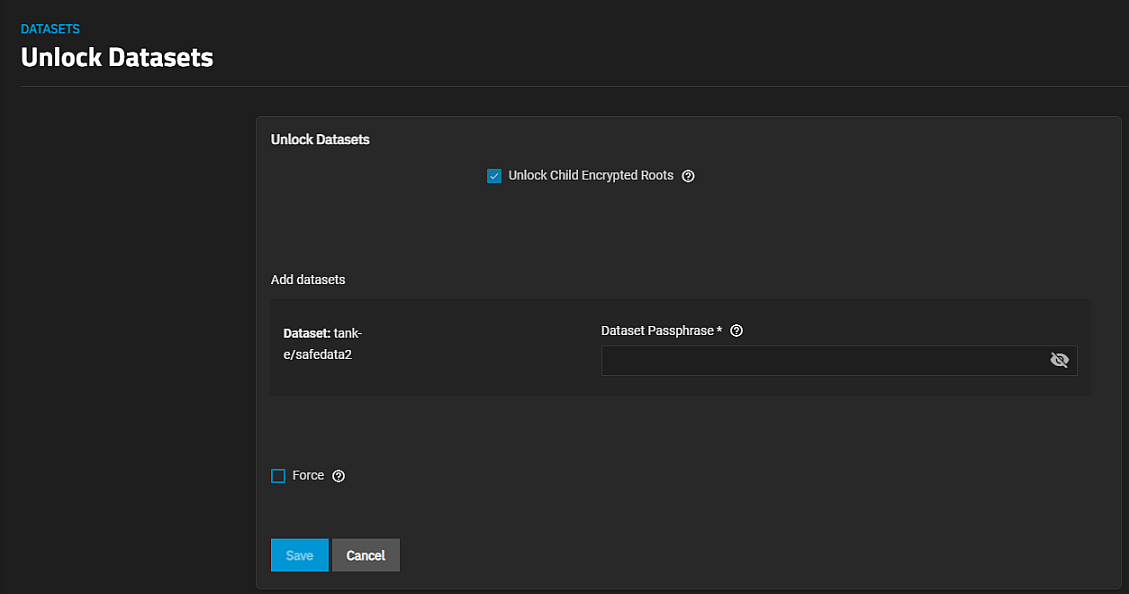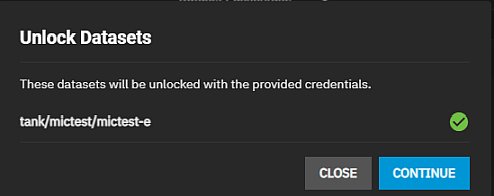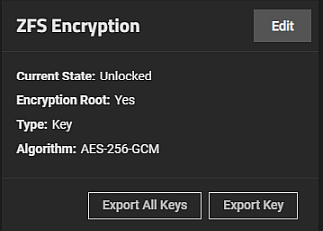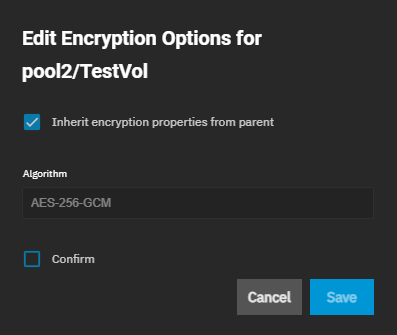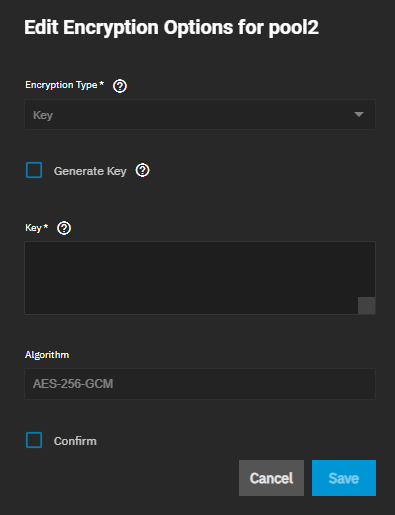Storage Encryption
13 minute read.
TrueNAS offers ZFS encryption for your sensitive data in datasets and zvols.
Users are responsible for backing up and securing encryption keys and passphrases! Losing the ability to decrypt data is similar to a catastrophic data loss.
Data-at-rest encryption is available with:
- Self Encrypting Drives (SEDs) using OPAL or FIPS 140.2 (Both AES 256)
- Encryption of specific datasets (AES-256-GCM)
The local TrueNAS system manages keys for data-at-rest. Users are responsible for storing and securing their keys. TrueNAS includes the Key Management Interface Protocol (KMIP).
Encryption is for users storing sensitive data. Pool-level encryption applies to the root dataset that shares the same name as the pool. It does not apply encryption to the storage vdev or the disks in the pool. Child datasets or zvols must be configured to inherit encryption from the parent dataset.
TrueNAS automatically generates a root dataset when you create a pool. Select Encryption on the Pool Creation Wizard screen when you create the pool to encrypt the root dataset. TrueNAS forces encryption of all child datasets and zvols within an encrypted root or parent dataset created using the TrueNAS UI. By default, child datasets inherit encryption settings from the parent. Disabling Inherit (encrypted) under Advanced Options allows modifying the encryption configuration for a child dataset but you cannot change a child dataset of an encrypted parent dataset to unencrypted.
As of TrueNAS 22.12.3 or later, the TrueNAS UI does not allow you to create unencrypted datasets within an encrypted pool or parent dataset. However, datasets created outside the UI, such as those created programmatically or manually via shell access, might not inherit encryption unless properly configured. For example, the ix-apps dataset on the pool selected for applications does not inherit encryption settings.
If the system has only one pool, we recommend that you do not use pool-level encryption for this pool. Leave Encryption unselected on the Pool Creation Wizard screen to create a pool with an unencrypted root dataset. You can create unencrypted and encrypted datasets within an unencrypted pool (root dataset).
If your system loses power or you restart the system, all encrypted datasets and zvols automatically lock to protect data.
TrueNAS uses lock icons to indicate the encryption state of a root, parent, or child dataset in the tree table on the Datasets screen. Each icon shows a text label with the state of the dataset when you hover the mouse over the icon.
The Datasets tree table includes lock icons and descriptions that indicate the encryption state of datasets.
| Icon | State | Description |
|---|---|---|
| Locked | Displays for locked encrypted root, non-root parent and child datasets. | |
| Unlocked | Displays for unlocked encrypted root, non-root parent and child datasets. | |
| Locked by ancestor | Displays for locked datasets that inherit encryption properties from the parent. | |
| Unlocked by ancestor | Displays for unlocked datasets that inherit encryption properties from the parent. |
A dataset that inherits encryption shows the mouse hover-over label Locked by ancestor or Unlocked by ancestor.
Select an encrypted dataset to see the ZFS Encryption widget on the Datasets screen.
The dataset encryption state is unlocked until you lock it using the Lock button on the ZFS Encryption widget. After locking the dataset, the icon on the tree table changes to locked, and the Unlock button appears on the ZFS Encryption widget.
Before creating a encrypted pool (root dataset) or dataset, decide if you want to encrypt all child datasets, zvols, and data stored on that dataset.
If your system does not have enough disks to create a second storage pool, we recommend not using encryption at the pool level. Apply encryption at the dataset level to non-root parent or child datasets.
All pool-level encryption is key-based encryption. When prompted, download the encryption key and keep it stored in a safe place where you can back up the key file. You cannot use passphrase encryption at the pool level.
You cannot change an existing dataset from encrypted to unencrypted. You can only change the dataset encryption type (key or passphrase).
TrueNAS 22.12.3 or later forces encryption for all child datasets and zvols within an encrypted root or parent dataset that are using the TrueNAS UI. However, datasets created outside of the UI, such as those created programmatically or manually via shell access, might not inherit encryption unless properly configured. For more granular control and awareness, we do not recommend users configure pool-level encryption of the root dataset. Instead, create an unencrypted pool and populate it with encrypted or unencrypted child datasets, as needed.
Go to Storage and click Create Pool on the Storage Dashboard screen. Or click Add to Pool on the Unassigned Disks widget and click Add to New to open the Pool Creation Wizard.
Enter a name for the pool, then select Encryption. Select the layout for the data VDEV and add the disks. A warning dialog displays after selecting Encryption.
Read the warning, select Confirm, and then click I UNDERSTAND.
A second dialog opens where you click Download Encryption Key for the pool encryption key.
Click Done to close the window. Move the encryption key to safe location where you can back up the file.
Add the VDEVs to the pool you want to include, then click Save to create the pool with encryption.
To add an encrypted dataset, go to Datasets.
Select a dataset on the tree table where you want to add a new dataset. The default dataset selected when you open the Datasets screen is the root dataset of the first pool on the tree table list. If you have more than one pool and want to create a dataset in a pool other than the default, select the root dataset for that pool or any dataset under the root where you want to add the new dataset.
Click Add Dataset to open the Add Dataset screen, and enter a name.
Select the Dataset Preset option you want to use. Options are:
- Generic for non-SMB share datasets such as iSCSI and NFS share datasets, datasets for Instances (containers or virtual machines), or datasets not associated with application storage.
- Multiprotocol for datasets optimized for SMB and NFS multi-mode shares or to create a dataset for NFS shares.
- SMB for datasets optimized for SMB shares.
- Apps for datasets optimized for application storage.
Generic sets ACL permissions equivalent to Unix permissions 755, granting the owner full control and the group and other users read and execute privileges.
SMB, Apps, and Multiprotocol inherit ACL permissions based on the parent dataset. If there is no ACL to inherit, one is calculated granting full control to the owner@, group@, members of the builtin_administrators group, and domain administrators. Modify control is granted to other members of the builtin_users group and directory services domain users.
Apps includes an additional entry granting modify control to group 568 (Apps).
Click Advanced Options. To add encryption to a dataset, scroll down to Encryption Options and select the inherit checkbox to clear the checkmark. If the parent dataset is unencrypted and you want to encrypt the dataset select the Inherit (non-encrypted) checkbox to clear it and show the Encryption option. If the parent dataset is encrypted and you want to change the type, select Inherit (encrypted) to show the encryption configuration options. To keep the dataset encryption settings from the parent, leave inherit selected.
Decide if you want to use the default key type encryption and want to let the system generate the encryption key. To use key encryption and an existing key, disable Generate Key to display the Key field. Enter the existing key in this field.
To change to passphrase encryption, select Passphrase from the Encryption Type dropdown.
The passphrase must be longer than 8 and less than 512 characters.
Keep encryption keys and/or passphrases safeguarded in a secure and protected place. Losing encryption keys or passphrases can result in permanent data loss!
Select the encryption algorithm from Algorithm or use the recommended default.
Leave the default selection if you do not have a particular encryption standard you want to use.
You cannot add encryption to an existing dataset. You can change the type of encryption for an already encrypted dataset using the Edit option on the ZFS Encryption widget for the dataset.
Save changes to the encryption key or passphrase, update your saved passcodes and keys file, and back up that file.
To change the encryption type, go to Datasets, select the encrypted dataset on the tree table, then click Edit on the ZFS Encryption widget. The Edit Encryption Options dialog for the selected dataset opens.
Before making changes to a locked encrypted dataset you must unlock it.
If the dataset inherits encryption settings from a parent dataset, to change this, clear the Inherit encryption properties from parent checkbox to display the key type encryption setting options.
If the encryption type is set to passphrase, you can change the passphrase, or change Encryption Type to key. You cannot change a dataset created with a key as the encryption type to passphrase.
Key type options are Generate Key (pre-selected) or clear to display the Key field. Enter your new key in this field.
To change the passphrase for passphrase-encryption, enter a new passphrase in Passphrase and Confirm Passphrase.
Use a complex passphrase that is not easy to guess. Store in a secure location subject to regular backups.
Leave the other settings at default, then click Confirm to activate Save.
Click Save to close the window. The ZFS Encryption widget updates to reflect the changes made.
You can only lock and unlock an encrypted dataset if it is secured with a passphrase instead of a key file. Before locking a dataset, verify that it is not currently in use.
Select the encrypted dataset on the tree table, then click Lock on the ZFS Encryption widget to open the Lock Dataset dialog with the full path name for the dataset.
Use the Force unmount option only if you are certain no one is currently accessing the dataset. Force unmount boots anyone using the dataset (e.g. someone accessing a share) so you can lock it. Click Confirm to activate Lock, then click Lock.
You cannot use locked datasets.
To unlock a dataset, go to Datasets then select the locked dataset on the tree table. Click Unlock on the ZFS Encryption widget to open the Unlock Dataset screen.
Enter the key if key-encrypted, or the passphrase into Dataset Passphrase and click Save.
Select Unlock Child Encrypted Roots to unlock all locked child datasets if they use the same passphrase.
Select Force if the dataset mount path exists but is not empty. The unlock operation fails when this happens. Using Force allows the system to rename the existing directory and file where the dataset should mount which prevents the mount operation from failing. A confirmation dialog displays.
Click CONTINUE to confirm you want to unlock the datasets. Click CLOSE to exit and keep datasets locked. A second confirmation dialog opens confirming the datasets unlocked. Click CLOSE. TrueNAS displays the dataset with the unlocked icon.
Users are responsible for backing up and securing encryption keys and passphrases! Losing the ability to decrypt data is similar to a catastrophic data loss.
To encrypt a Zvol, select a parent dataset and then create a new Zvol. If the parent dataset is encrypted, select Inherit (encrypted) under Encryption Options. If the parent dataset is not encrypted, disable Inherit (non-encrypted), select Encryption, and then configure the Encryption Type and related settings.
Next, go to Datasets and click on the Zvol and locate the ZFS Encryption widget.
To change encryption properties from passphrase to key or enter a new key or passphrase, select the zvol, then click Edit on the ZFS Encryption widget.
If Encryption Type is set to Key, type an encryption key into the Key field or select Generate Key. If using Passphrase, enter a passphrase of eight to 512 characters.Use a passphrase complex enough that is not easily guessed. After making any changes, select Confirm, and then click Save.
Save changes to the encryption key or passphrase, update your saved passcodes and keys file, and back up the file.
There are two ways to manage the encryption credentials, with a key file or passphrase. Creating a new encrypted pool automatically generates a new key file and prompts users to download it.
To manually back up a root dataset key file, click Export Key on the ZFS Encryption widget.Always back up the key file to a safe and secure location.
See Changing Dataset-Level Encryption for more information on changing encryption settings.
A passphrase is a user-defined string of at least eight characters in length, and that is required to decrypt the dataset. A passphrase is a user-defined string of eight to 512 characters that is required to decrypt the dataset. The pbkdf2iters is the number of password-based key derivation function 2 (PBKDF2) iterations to use for reducing vulnerability to brute-force attacks. Users must enter a number greater than 100000.
TrueNAS users should either replicate the dataset/Zvol without properties to disable encryption at the remote end or construct a special JSON manifest to unlock each child dataset/zvol with a unique key.
Replicate every encrypted dataset you want to replicate with properties.
Export key for every child dataset that has a unique key.
For each child dataset construct a proper json with poolname/datasetname of the destination system and key from the source system like this:
{"tank/share01": "57112db4be777d93fa7b76138a68b790d46d6858569bf9d13e32eb9fda72146b"}Save this file with the extension
.json . On the remote system, unlock the dataset(s) using properly constructed
json files.
Uncheck properties when replicating so that the destination dataset is not encrypted on the remote side and does not require a key to unlock.
Go to Data Protection and click ADD in the Replication Tasks window.
Click Advanced Replication Creation.
Fill out the form as needed and make sure Include Dataset Properties is NOT checked.
Click Save.
Go to Datasets on the system you are replicating from. Select the dataset encrypted with a key, then click Export Key on the ZFS Encryption widget to export the key for the dataset.
Apply the JSON key file or key code to the dataset on the system you replicated the dataset to.
Option 1: Download the key file and open it in a text editor. Change the pool name/dataset part of the string to the pool name/dataset for the receiving system. For example, replicating from tank1/dataset1 on the replicate-from system to tank2/dataset2 on the replicate-to system.
Option 2: Copy the key code provided in the Key for dataset window.
On the system receiving the replicated pool/dataset, select the receiving dataset and click Unlock.
Unlock the dataset. Either clear the Unlock with Key file checkbox, paste the key code into the Dataset Key field (if there is a space character at the end of the key, delete the space), or select the downloaded Key file that you edited.
Click Save.
Click Continue.




